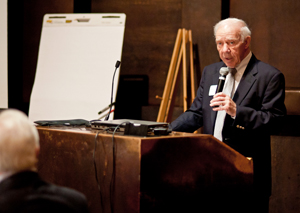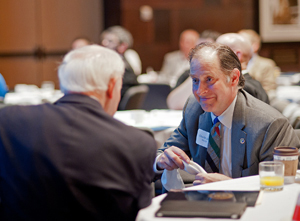|
By Greg Ruhland, Office of Freight & Commercial Vehicle Operations

Former Congressman James Oberstar spoke at the Future Freight Scenario planning workshop June 13 at the University of Minnesota’s McNamara Alumni Center. Photo by David Gonzalez
|
Providing a framework to develop a more flexible, adaptive freight transportation system was the focus of this year’s Future Freight Scenario planning workshop sponsored by the Office of Freight and Commercial Vehicle Operations.
MnDOT staff joined more than 60 colleagues from public and private industry June 13 at the University of Minnesota’s McNamara Alumni Center in Minneapolis. Participants brainstormed strategies to better prepare, adapt and respond to a range of potential futures.
Scenario planning can be used in conjunction with other methods to improve the quality of long-range planning, said John Tompkins, OFCVO project manager, adding that the workshop results will support MnDOT's upcoming Statewide Freight Plan update.
Commissioner Charlie Zelle and former Congressman James Oberstar shared their perspectives on Minnesota's dynamic transportation system. They spoke of the important roles of freight and rail, and how the Statewide Freight Plan update will intentionally engage private industry and the public.
“To be efficient, all transportation modes need to be interconnected,” Zelle said.
Oberstar emphasized the need for continued investment in a variety of transportation modes.
“Our aging transportation system is not keeping up with the pace of international trade,” he said. “We are losing our edge to competitors in the global economy.”
Oberstar noted the freight rail system’s need for expanded capacity, and the fuel efficiency and capacity advantages of river barge transportation.
“The most challenging issue, of course, is financing,” he said.

Former Congressman James Oberstar spoke with Commissioner Charlie Zelle during the Future Freight Scenario planning workshop June 13 at the University of Minnesota’s McNamara Alumni Center. Photo by David Gonzalez
|
A series of facilitated breakout sessions, in which small groups were presented with one of four possible futuristic scenarios, followed the introductory remarks. Each scenario—Global Marketplace, Millions of Markets, One World Order, and Naftastique—was characterized by differences in population, industry, energy, governance structures, trade or other conditions. Each group answered the question: What could we have done to prepare ourselves for the world we are in?
To answer that, discussions focused on key implications for freight movement by truck, rail, water and air with respect to needs, costs and policy responses such as public-private partnerships, competitive advantages, environmental impacts and return-on-investment.
Group facilitators compared notes from the various futures. They reported back to the attendees on which transportation trends and policies consistently supported the full range of scenarios, and which strategies worked only in a limited way or not at all in some of the scenarios.
“The themes of flexible and responsive multi-modal freight transportation, energy efficiency and responsiveness to community and customer needs were clearly more effective over a wide range of outcomes than trying to pick a preferred mode, or investing in an expected narrow world outcome,” Tompkins said.
The workshop design was based on a tool kit developed through the National Cooperative Highway Research Program project 20-83. For more information, the project report can be accessed at:
www.trb.org/Main/Blurbs/168694.aspx. |



